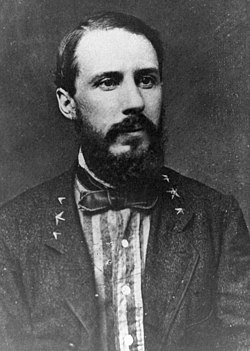Edward Porter Alexander
| Edward Porter Alexander | |
|---|---|

Edward Porter Alexander
photo taken between 1862 and 1864 |
|
| Born |
May 26, 1835 Washington, Georgia |
| Died | April 28, 1910 (aged 74) Savannah, Georgia |
| Place of burial | Magnolia Cemetery, Augusta, Georgia |
| Allegiance |
|
| Service/branch |
|
| Years of service | 1857–61 (USA) 1861–65 (CSA) |
| Rank |
|
| Commands held | Artillery |
| Battles/wars | |
| Other work | Railroad executive, planter, and author |
Edward Porter Alexander (May 26, 1835 – April 28, 1910) was a military engineer, railroad executive, planter, and author. He served first as an officer in the United States Army and later, during the American Civil War (1861–1865), in the Confederate Army, rising to the rank of brigadier general.
Alexander was the officer in charge of the massive artillery bombardment preceding Pickett's Charge, on the third day of the Battle of Gettysburg, and is also noted for his early use of signals and observation balloons during combat. After the Civil War, he taught mathematics at the University of South Carolina in Columbia, spent time in Nicaragua, and wrote extensive memoirs and analyses of the war, which have received much praise for their insight and objectivity. His Military Memoirs of a Confederate were published in 1907. An extensive personal account of his military training and his participation in the Civil War was rediscovered long after his death and published in 1989 as Fighting for the Confederacy.
Alexander, known to his friends as Porter, was born in Washington, Georgia into a wealthy and distinguished family of planters of the Old South. He was the sixth of ten children of Adam Leopold Alexander and Sarah Hillhouse Gilbert Alexander. He became the brother-in-law of Alexander R. Lawton and Jeremy F. Gilmer. He graduated from the United States Military Academy at West Point in 1857, third in his class of 38 cadets, and was brevetted a second lieutenant of engineers. He briefly taught engineering and fencing at the academy before he was ordered to report to Brig. Gen. Albert Sidney Johnston for the Utah War expedition. That mission ended before he could reach Johnston, and Alexander returned to West Point. He participated in a number of weapon experiments and worked as an assistant to Major Albert J. Myer, the first officer assigned to the Signal Corps and the inventor of the code for "wig-wag" signal flags, or "aerial telegraphy". Alexander was promoted to second lieutenant on October 10, 1858.
...
Wikipedia
